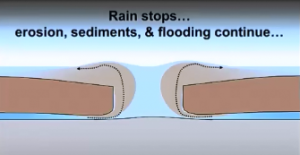HPT 101: Lesson 4: Liquefaction
In this lesson, we learn about sedimentation and introduce liquefaction, and see how these mechanisms could have produced the layers strata we see in the “geological record.”
****************************
VIDEOS:
Video 4A: Water flow and water hammers (23 min)
Here is the template page you will need to print out: HPT101 Video 4A template page
For this lesson, I will ask you to access three YouTube videos on your own, to avoid copyright issues (if I embed them in my own video). The channel is called Practical Engineering and should be easy to find since it has many subscribers. (If the links below don’t work for some reasons, you can simply search youtube using the name of the channel plus the name of the video.)
1: “What is Water Hammer?”
2: “What is Steam Hammer?”
3: “How to Collapse a Pipe by Closing a Valve”
Video 4B: How water sorts things (18 min)
Here is the template page your will need: HPT101 Lesson 4B template page
Video 4C: Liquefaction during the Flood (38 min.)
Here is the template page to print: HPT101 4C template page
BONUS VIDEOS on the formation of coal:
Hydroplate Theory doesn’t go into specifics for exactly how coal formed during this Flood Phase. Other creation researchers have done a great job of filling in the details. Here are some videos from the series “Is Genesis History?” that discuss how the mainstream story about how coal formed can’t possibly be true, and how conditions during the Flood were ideal for coal formation. The videos are like field trips, as they take you to actual sites. The first video also shows lots of non-coal sedimentary layers and Dr Kurt Wise talks about how the pebbles and tree trunks embedded in these layers tell us a lot about how fast the water was flowing and in what direction (consistent with HPT). Also, when Dr Wise talks about massive earthquakes, can you think of how HPT would explain at least some of these earthquakes? (Each video runs about 20 minutes.)
https://www.youtube.com/watch?v=zjygKkJ377w
https://www.youtube.com/watch?v=0aonGWZjKS8
*******************************************************
Suggested activities for this lesson:
NOTE: If you don’t want to actually do the labs that’s okay, you can learn just by watching the videos, too. (The videos are all very short.)
Activity 4.1: EASY LAB YOU CAN DO AT HOME: Make water flow up
In this lab, water will flow against gravity because the air pressure above it is lower than outside the jar.
https://www.youtube.com/watch?v=Te9vKOsfOcU
Activity 4.2: ANOTHER FUN LAB TO DO AT HOME: Experimenting with density
You can extend this lab by adding more objects. I added almonds, metal binder clips, carrot, potato, cheese, apple, and a marble. I used Karo syrup as the bottom layer. You can use molasses or honey or pancake syrup. The Karo syrup was really thick and objects took a long time to either sink or rise through it, but they did eventually. Have duplicates of the objects so you can try letting them go at the top versus the bottom.
https://www.youtube.com/watch?v=Z50jEi1igNQ
Activity 4.3: A LIQUEFACTION LAB YOU CAN DO AT HOME
All you need for this lab is a container of sand, water, and a few objects to either bury or place on top of the sand.
https://www.youtube.com/watch?v=b_aIm5oi5eA
Activity 4.4: A DENSITY “TOY” you can make
This demo is made of inorganic things that won’t rot or stink, so it will keep for a long time. And every time you turn it over it will do the same thing! The particles will always fall at the same speed. All you need is a bottle of mineral oil (I bought a bottle of baby oil and just dumped a little out so the objects would fit in and not overflow the bottle), and some various objects that have different densities, or shapes or sizes. You don’t have to use the objects I did. (video runs just 2 minutes)
Activity 4.5: A VIDEO LAB SHOWING FLOCCULATION
This 1-minute video shows someone adding a chemical to muddy-looking water in order to start the process of flocculation. Once the microscopic particles start to stick together, they will become so large that gravity will pull them down to the bottom of the bottle. (How does this relate to sedimentation during the Flood? Floccution in certain places could have caused particles to fall out of the water very quickly.)
https://www.youtube.com/watch?v=WsfWeLApRl0
Activity 4.6: LAB about flocculation you can do at home
This video will show you how to do an experiment with a bottle of cola and a few spoons of milk. This is sort of an organic version of flocculation, where the milk is “curdled” by the acid in the cola, which causes a chemical reaction that produces solid particles that fall to the bottom of the bottle. (I did this experiment over a year ago and my bottle is still sitting there full of clear fluid and all the brown stuff on the bottom. No mold, nothing yucky. Yet.)
https://www.youtube.com/watch?v=JwIZqoMgrx8
********************************************
SUGGESTED FOLLOW-UP ACTIVITIES for students using this course for credit:
READING: Read pages: 195-202 in the online book (All the things we went over in this lesson. Stop when you get to “Liquefaction During the Compression Event”)
VIDEO: Watch a Japanese video showing a liquefaction lab. (Why would this be a hot topic for Japanese students?)
https://www.youtube.com/watch?v=-eH5fh0YEuQ


